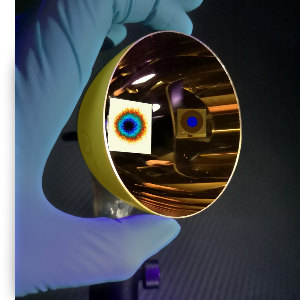One-way for thermal radiation
1 Sept 2021
LMU physicists have developed a novel method for contactless cooling of objects.
1 Sept 2021
LMU physicists have developed a novel method for contactless cooling of objects.

Contactless cooling of a sample by directional steering of thermal radiation. Nicola Kerschbaumer | © Jochen Feldmann/ LMU
Everyone knows what it’s like to be out on a cold and cloudless winter night when the skies are studded with stars. In the open the cold is all too keenly felt. But in a forest, under the protective cover of the trees, it is less so. The reason for this difference is thermal radiation, which is emitted by the body and, depending on the nature of one’s surroundings, may be replaced by a smaller amount of radiation emanating from the environment. With a temperature of −270°C, the Universe is far colder than our own immediate surroundings, and therefore emits hardly any thermal radiation. Research groups around the world have recently begun to explore novel methods for cooling buildings and clothing, even in broad daylight, by enhancing the rate of heat exchange with the Universe – without the need for further energy consumption. However, potential applications of these methods for technological or experimental purposes – on a small scale – have rarely been investigated up to now.
Researchers led by Professor Jochen Feldmann at LMU’s Nano-Institute have now succeeded in generating a cold gradient in an experimental sample by targeted and contactless control of the distribution of thermal radiation. “To do so, we simulated the effect of the remote Universe with the aid of a distant cryostat,” says Nicola Kerschbaumer, a PhD student in Feldmann’s team and first author of the study. A cryostat can be thought of as a kind of cooling unit, which is designed to reach and maintain extremely low temperatures. With the aid of a special optical set-up and an arrangement of elliptical mirrors, the team was able to collect the long-wave thermal radiation emitted by the sample (which is initially at room temperature), and focus it onto a plate placed in the center of the cryostat. In this way, they were able to create a kind of one-way street for the emitted radiation, which resulted in the effective cooling of the sample. In an initial application, this contactless method of cooling was shown to be particularly effective for what is known as the supercooling of liquids.
The researchers believe that their new contactless method, which uses “radiative cooling” to generate a cold gradient in a sample, will find many applications. According to Privatdozent Theobald Lohmüller, Leader of the Biophotonics Group in the Nano-Institute and co-author of the study, contactless thermal manipulations of biological samples will be of particular interest.
Publication:
N.M. Kerschbaumer, S. Niedermaier, T. Lohmüller and J. Feldmann
Contactless and spatially structured cooling by directing thermal radiation
Scientific Reports 11, 16209 (2021)
https://doi.org/10.1038/s41598-021-95606-2
Contakt:
Prof. Dr. Jochen Feldmann and M. Sc. Nicola Kerschbaumer
Chair for Photonics and Optoelectronics
Nano-Institute Munich
feldmann@lmu.de, nicola.kerschbaumer@lmu.de
www.phog.physik.uni-muenchen.de